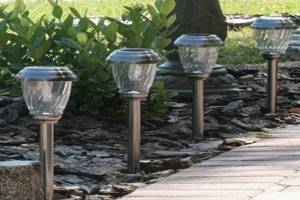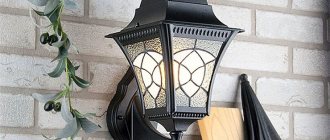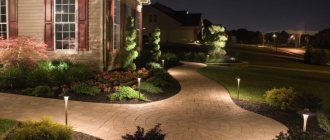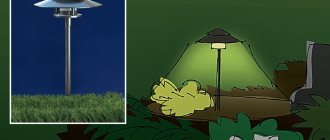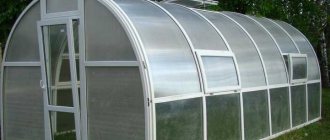Repair and decoration
04/17/2018 Anastasia Prozheva
Twilight absorbs the beauty of any garden, making it scary and lifeless. However, proper lighting of garden paths can radically change the situation and give the garden a certain individuality and security at night. In this article we will tell you how to make such lighting, what to look for when choosing lamps, and show you ready-made options.
Basic requirements and principles of lighting organization
When designing an electrical circuit for garden plots, you need to choose the right equipment that will work in both snow and rain. During the daytime, the backlight should be turned off. To reduce the cost of installing devices and lamps, you need to think about the location of the lamps in advance. If you place them along pedestrian paths, you can improve the landscape of the site.
The light emitted by lamps should not be bright, but soft. Electricity is not cheap; you need to choose devices that save kilowatts. In order for the lanterns to serve for a long time, not to get wet in the rain, and not to become covered with dust, you need to think about how to protect them.
The area will look well-groomed if you install lamps that harmoniously combine with the landscape design.
Festive decorative lighting of the site
Many owners of country cottages often carry out non-standard decorative lighting on the eve of holidays (New Year, Easter, March 8). To create a special atmosphere, you can use the following types of lamps:
Fairy lights
They can be completely wrapped around trees or used to stylize the facade: placed above window openings, along the perimeter of the roof. For trees, garlands in the form of thin sticks with LEDs inside can also be used.
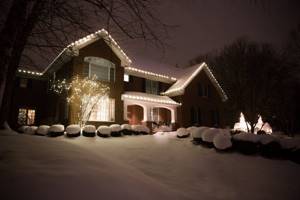
Grids with LEDs (a subtype of modern garlands)
They can be fixed in flower beds or placed on the walls of the house.
Glowing figures
They are a metal frame supplemented with LEDs. They produce a bright, soft light, allowing you to illuminate a small area around you. There are also small figures (in the form of New Year's wreaths, flowers or flat silhouettes) that can be mounted on the facade for festive lighting.
Execution options
Lanterns in the garden are connected for different purposes, and lighting is divided into several types.
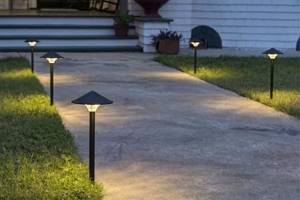
Functional
To make it convenient to move around the site at night, climb stairs, wander along paths, lamps that can be turned on manually or automatically are installed on poles, at gates and gates at a height of 2–3 meters.
The front doors are equipped with outdoor sconces. The parking area and the path to the garage are illuminated with the help of lanterns mounted on supports about a meter high. The power of gas-discharge sources is selected taking into account:
- number of lamps;
- zone area;
- width of the tracks.
Functional lighting is controlled automatically or manually. They install a relay that activates when it gets dark, and program the on time.
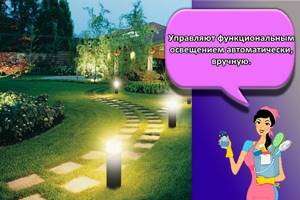
Decorative
To create a cozy atmosphere, a romantic and mysterious atmosphere in the garden plot, and to give expressiveness to the building and landscape, a decorative lighting system is installed, which is activated using a remote control located inside the house.
See also
How to install a sink above the washing machine in the bathroom with your own hands
Architectural
To decorate the facade of the building, lamps or lanterns are installed. For this purpose, point sources can be used and a general illumination system can be connected. Lanterns that are placed throughout the area help to emphasize the elegance of a flower bed or alpine hill, or to highlight a garden sculpture, pond or shrubs. Dotted columns illuminate each object.
For important events and family holidays, the garden plot is decorated with illumination.
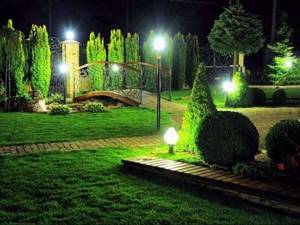
Security
Emergency lighting performs a strictly defined role - it protects the territory of the dacha from the invasion of uninvited guests. It consists of gas discharge lamps.
The lamps are positioned so that the sensors block the entrance to the building. The system turns on when a moving object or spotlight appears. The lamps go out after a preset interval, which can be adjusted independently.
Types of lighting
Garden lighting can be divided into several types: technical (functional), decorative, security, and architectural.
If you decide to make your own garden lighting, you need to remember that technical lighting is done at a certain height, but not too high, so as not to disturb the comfort. An example of technical lighting is lights at the gate. The light should fall from top to bottom.
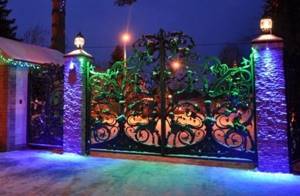
Decorative lighting should highlight the advantages of landscape design and complement it with new colors. This lighting is usually installed in recreation areas, near alpine slides, and ponds. After all, just one backlight can completely change the picture of the garden.
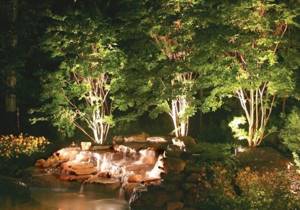
Security lighting serves for protection and creates the effect of the presence of people. This lighting can be divided into 2 types. In the first type, the lighting automatically turns on at night (photocells turn it on and off). In the second case, the lighting turns on at the slightest movement (motion sensors are installed here).
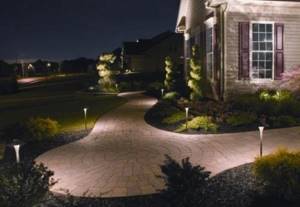
Architectural lighting, as a rule, not only illuminates the house, but also combines technical and decorative functions. Also see possible options for architectural lighting of houses on the website https://ekodis.com/stati/240-novogodnee-osveshchenie

How to choose lighting fixtures
Lanterns installed in the yard must have a safety index of at least IP44. When determining the location for the lamps, the voltage value is calculated. For landscape lighting, operating from a 220 V network, a step-down transformer is used.
For a garden plot, it is recommended to purchase devices with a voltage of 24 or 12.

By mode of action and luminous output
They are classified according to their mode of action and light output.
Incandescent lamps
In an artificial source, when an electric current flows, the tungsten coil heats up. When the switch is pressed and the circuit is closed, the temperature of the filament increases, and when the indicator rises, the light comes on.
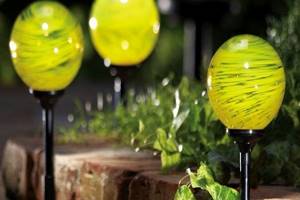
Halogen
If the garden area is small, it makes sense to install lamps that contain a buffer gas in the cylinder, which increases the temperature of the coil. The service life of the product is up to 4 thousand hours.
Halogen lamps do not flicker and have high color rendering.
Luminescent
Gas-discharge mercury lamps, which are installed in shopping centers and workshops, can also be placed in the garden. The design is made in the form of a glass tube, sealed on both sides. The luminescent device is connected to a power source and emits light. Built into the lamp:
- cathodes;
- gas exhaust pipes;
- panel;
- pins.
The device operates for 15 thousand hours, but when the temperature drops to 5 °C it can fail, it is afraid of moisture. Install the lanterns in the garden, placing them in the housing.

Metallogenic
Lamps with a light output of 100 lm/W do not last much less than fluorescent devices and allow you to save energy. The devices use mercury, which settles on the surface of the burner. When heated, the substance breaks down into ions that emit light.
Metallogenic lamps have high power, operate at any temperature, and heat up instantly.
See also
Types of heaters for home and apartment, which one is better to choose

Sodium
Gas-discharge devices, created as a result of the improvement of incandescent devices, are used to illuminate streets, courtyards, and summer cottages. Inside the lamp there is a tube filled with sodium vapor. When current passes through the device, an arc is formed between the 2 electrodes. The main beam of radiation consists of metal ions, which give the light an orange tint. To connect the lamp, an ignition device is used that generates pulses of thousands of volts.
LEDs
When an electric current passes, semiconductor devices produce radiation of a specific color, which depends on the crystal used. LEDs last up to three decades.
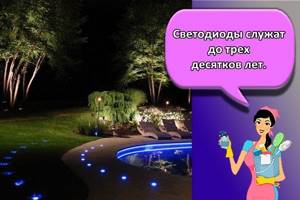
By design
Lamps installed on a summer cottage must not only be durable, but also fit into the landscape and organically complement the landscape.
Floor lamps and lamp posts
To design a lighting scheme for a garden with numerous decorative elements - flower beds, figurines, armchairs, it is recommended to choose simple, laconic devices. Fancy lamps are more suitable for an area furnished in a minimalist style.
Floor lamps and lanterns are usually installed along the main path so that they do not blind the eyes.

Light posts and bollards
In order to illuminate not the entire area, but only to outline the direction, highlight distant paths, and emphasize the attractiveness of the landscape, retractable bollards and shining bollards are installed.
Glowing stones
To decorate the garden, they dig a lake, install fountains, make hanging flower beds, and connect vintage lanterns. With the onset of dusk, the area looks impressive and mysterious if you spray fluorescent paint on the curbs of paving slabs, pebbles, and gravel lying along the path.
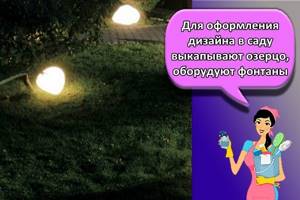
LED bulbs
Polymer stones in which batteries are built look bright and exotic, making it easier to move along paths at night. LED lamps, which additionally perform a decorative function, are placed when laying paving slabs.
Solar powered devices
Devices whose batteries are charged by ultraviolet rays and in the evening by LEDs are used to decorate the landscape.
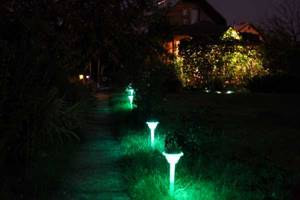
Carbonate and polycarbonate
Spherical lamps made of transparent thermoplastic material, installed in summer cottages, perform a decorative function and emit a mysterious light.
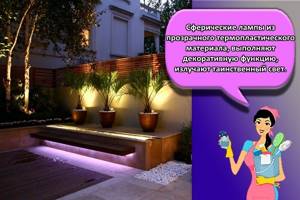
Lighting options
Garden lamps in the shape of stones
This method can only be used as decorative lighting. There is no special effort in installation, you only need to show your imagination and nothing more. You can find stones of this type in any online store.
Watch another video.
Lanterns or floor lamps
They are used as the main lighting for the garden. Most often, with the help of them, the illumination of garden paths turns out excellent. It is better to install it to illuminate the main road to the house. Also read: best terrace lighting ideas.
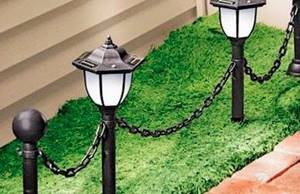
Important point! The light should only shine downwards; it can only get into a person’s eyes if he bends down.
Marking lighting
Related article: Table and benches for the gazebo: how to choose their design
Lamps of this type can be called “Bollards”, in simple words they can be designated as “Columns of Light”. They indicate only the direction of movement; it is optimal to install them on secondary tracks.
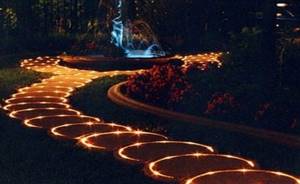
Solar lamps
The easiest option is to do:
- Buy.
- Stick it into the ground.
- Wait for the night.
That's all, but this method cannot be called good, if you do not have time and want to save money, then this option will be excellent. When choosing, we recommend paying attention to the manufacturer; Chinese ones, as a rule, last one season.
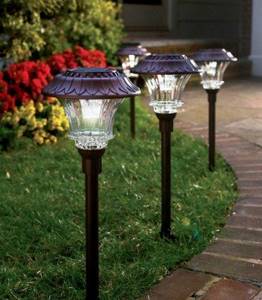
Choosing an installation location
To begin with, decide on a location.
Purpose
To ensure that all family members feel safe in the garden, lanterns and lamps should be installed along the paths, at the entrance to the yard, next to the gate and at the gate. To decorate the landscape, lamps are placed:
- Near the pool or fountain.
- Around the gazebo.
- Next to the children's playground.
- Near benches for rest.
Built-in and floor lamps are used to illuminate the facade of the house. They are placed in different places.
See also
Errors and codes with explanations of the Samsung washing machine, what to do in case of breakdowns
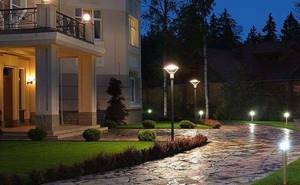
Height
Low posts and bollards are placed in rows at a distance of 60–70 cm from the ground surface. Such devices highlight paths and highlight the direction well.
Garden lanterns with a height of 1.5 m look harmonious on a spacious area, decorate the pedestrian area and wide paths.
Examples of using
With a large number of luminous stones, you can completely abandon traditional methods of street lighting. Magic pebbles can be used to decorate the borders of paths, thereby shaping their outline, illuminating the direction and marking the boundaries of the pedestrian zone.
Idea: small glowing stones (crumbs) can be used in the process of laying garden paths - simply add glowing stones to the concrete, thereby creating the effect of a starry sky.
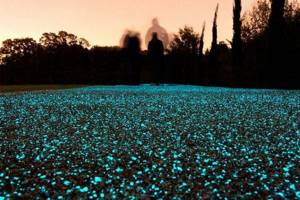
Glowing path of crumbs
Also on our website: lighting of a summer cottage.
In addition to being used for paths, luminous pebbles can be used to decorate flower beds and flower beds, or lay them out on the lawn or near large trees. Such lighting will look very harmonious near pools and ponds, as well as near recreation areas.

Plant lighting
It’s very easy to make glow-in-the-dark paths in your dacha with your own hands. Options for decorating a site using luminous elements are limited only by your imagination. With the help of such original crafts, the territory of the house will be filled with a magical atmosphere and bright colors!
From this video you will learn how to make a phosphor with your own hands.
How to do it yourself
You can install lighting in your dacha yourself if you have a diagram, the necessary materials, tools, and lamps.
Design
When developing a system for a garden plot, devices are selected, the option of their installation, the cable laying method are determined, and the amount of consumables is calculated.
Selection of tools and components
The lamps used must fit harmoniously into the landscape, withstand temperature fluctuations, and be protected from moisture.
To automatically turn on devices and save energy, you need to purchase rheostats and motion sensors.
You definitely need to buy terminals, pipes, and parts that are used to create a circuit for transmitting current.
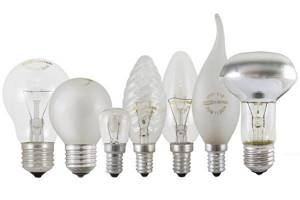
Choosing a cable laying method
Installation of wiring in a summer cottage is organized underground or performed at height. The first method is safe because the risk of system damage is minimal. However, it is easier to lay the cable over the air and install the distribution board in the house.
Installation instructions
Connections of wires, twisted with pliers and wrapped with insulating tape, are placed in junction boxes. The cable installed on the house is laid in a corrugated sleeve. To avoid the need for additional poles, use a galvanized cable. Wires carrying current must be protected with double insulation. The voltage used in everyday life is 220 V. A regular outlet is suitable for connecting to the network. You can determine the neutral wire with an indicator.

DIY garden path lighting: video
It will be interesting to know: How to make lighting in a garage without electricity.
The best posts
- Technology for installing plasterboard on the ceiling (step-by-step instructions): technical characteristics of plasterboard ceilings (video)
- DIY plaster crafts for the garden: MK with photos and videos
- DIY children's sofa at home
- [Like in a movie] New Year's interior from the movie "Home Alone"
- Forged gates: photos, models, varieties
- What air humidity should be at home?
- Studio design 25 sq. m: 2 versions (+45 photos)
- MOODBOARD: what is it and how to use it as interior decor?
Common Mistakes
Some garden owners carry out electrical work without drawing up a diagram, which leads to short circuits and other consequences.
Cheap lanterns and lamps that are purchased to save money cannot withstand the load.
The installation material is purchased without reserve, the cable cross-section is calculated incorrectly, low-voltage and power wires, aluminum and copper conductors are connected in one distribution box.
The work is carried out under voltage, but even replacing a lamp can cause a short circuit in a suburban area and cause a fire in the house.
